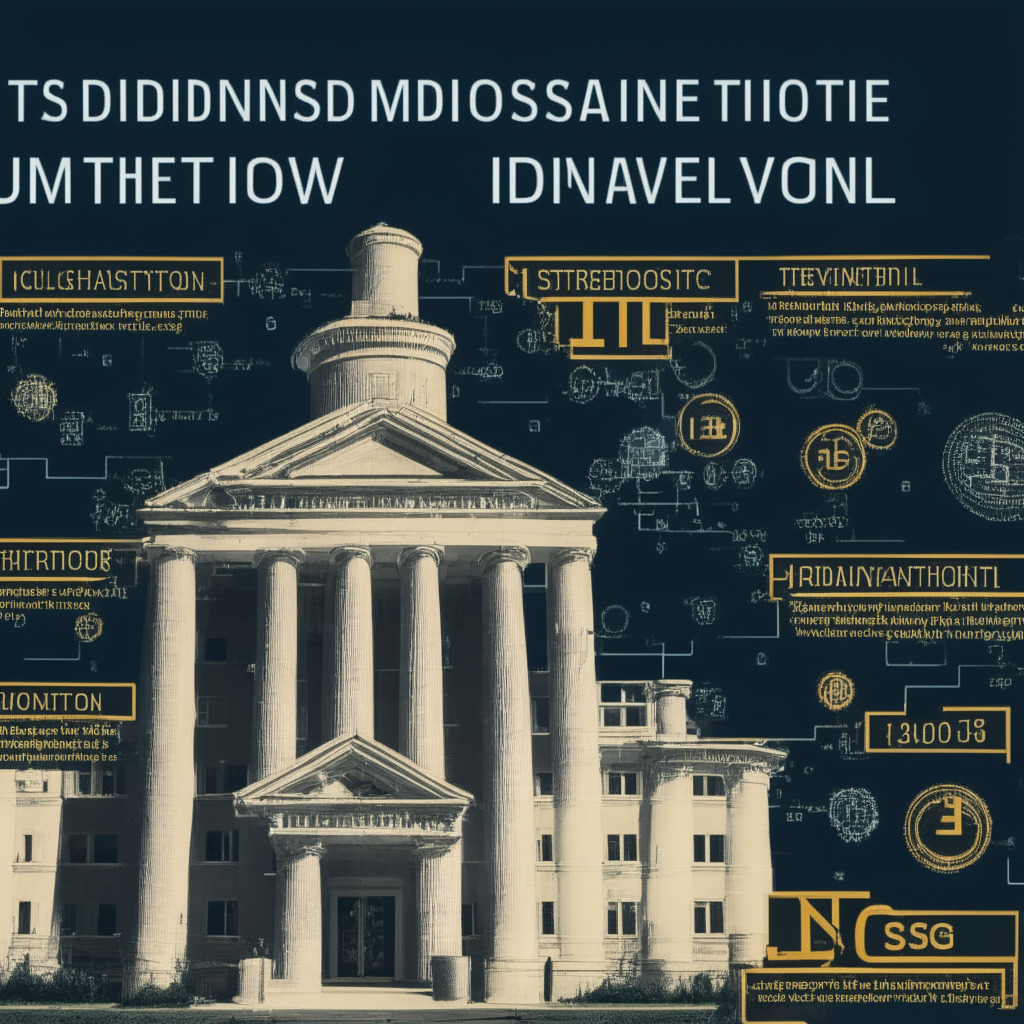“Hive Blockchain shifts its focus to artificial intelligence as Hive Digital Technologies, while remaining committed to Bitcoin and crypto mining. The company envisions AI and blockchain jointly promoting the development of Web3, potentially enhancing user privacy and data ownership.”
Search Results for: Riot Blockchain
Navigating the Tightrope: A Deep Dive into Recent Financials of Riot Platforms in the Crypto Market
Colorado-based Bitcoin mining firm, Riot Platforms, recently narrowed its Q2 net loss to $27.7 million by increasing its Bitcoin production. This operational strategy led to a push in total revenue up to $76.7 million, offering new perspectives on the operational aspects of blockchain enterprises. Despite the increase in revenue, the company’s share price stumbled, highlighting the intricate mechanics of the crypto market.
Hive Digital Technologies: A Bold Move from Blockchain to AI and Cloud Computing
“Hive Blockchain, now known as Hive Digital Technologies, is refocusing towards AI, cloud computing revenues, and GPU mining. They plan to use Nvidia GPUs for cloud services, demonstrating a shift from traditional blockchain technology while not completely discarding it.”
Bybit’s Entry Boosts Cyprus Crypto Scene: Comparing It to Malta’s Blockchain Island Status
Bybit, the world’s third most visited crypto exchange, has received license approval to operate as an exchange and custody service in Cyprus. This will contribute to the growing crypto ecosystem in Cyprus, offering trading between crypto and fiat currency pairs, and crypto-related financial services.
Blockchain Gaming Evolution: Last Remains, Web3 & Future Strategies
Blockchain-based gaming is booming, with Last Remains, a triple-A Web3 multiplayer battle royale zombie game, raising $4.75 million from major crypto investors. A partnership with Cointelegraph Accelerator highlights its focus on high-quality gameplay and the expertise of its developers from top gaming companies.
Crypto Mining Battle: Riot Platforms Sues Rhodian for $26M Amid Industry Turmoil
Riot Platforms, a crypto mining firm, has filed a petition against Rhodian Enterprises, a Texas-based Bitcoin miner, seeking recovery of over $26 million in unpaid fees. Riot claims Rhodian breached their contract by not paying hosting and service fees, adding that recovering the owed funds remains uncertain. The legal dispute highlights the growing pains in the crypto mining industry, but Riot’s increased mining output and strong financial position show resilience.
Striking a Balance: Implications of New SEC Cybersecurity Disclosure Regulations on Crypto Firms
“The SEC has ruled that significant public firms, such as cryptocurrency companies Coinbase, Marathon Digital, and Riot Blockchain, must disclose major cybersecurity breaches within four days. This rule signifies an intensified blend of finance, tech, and cybersecurity in our digital age, though concerns have been raised about feasibility and potential operational burdens.”
Analyzing Bitcoin Market Fluctuations: Impacts, Future Prospects, and Resiliency Amid Recession
“In his analysis, Mike Colonnese discusses recent Bitcoin (BTC) market fluctuations, attributing the sharp drop to SpaceX’s decision to devalue its BTC holdings and concerns sparked by Evergrande’s bankruptcy. He also outlines potential future trends, including possible boost in BTC prices if the Federal Reserve cuts rates amidst a recession, and impact of upcoming halving event in 2024.”
Emergence of Tech Adaptability: Digital Asset Miners Venturing into AI Services
“Digital asset miners are venturing into artificial intelligence, aiming to boost earnings and decrease dependency on conventional cryptocurrency operations. Notably, Bitcoin and Ethereum miners are driving this switch, while some miners continue mining other Proof-of-Work assets. Mining companies are rebranding to echo this trend, finding high-performance computing services for AI firms potentially more profitable than Bitcoin mining.”
Crypto Markets Calm as Storm Brews Behind the Scenes: Failures, Diversification, and Anticipated Swings
Major cryptocurrencies showed a stable trend, despite turbulence like the slump of SHIB partially due to its unsuccessful Ethereum layer 2 network, Shibarium. Ethereum co-founder, Vitalik Buterin, transferred $1 million worth of cryptocurrency whilst facing a market downturn. This turbulent environment led to a strategic shift for bitcoin miners into new business areas.
Exploring the New Horizons: How Crypto Miners Diversify Revenue Streams into AI Market
“Bitcoin and Ether miners are branching into new business areas including high performance computing services for the artificial intelligence industry, seeking to diversify revenue and reduce crypto reliance. This follows the Ethereum blockchain Merge, leaving a surplus of GPUs on the secondary market, used for gaming, rendering services and mining other cryptocurrencies.”
Hut 8’s $50M Credit Boost: Analyzing HODL Strategy & Merger Implications in Crypto Mining
Canadian Bitcoin mining company Hut 8 Mining recently secured a $50 million credit facility through Coinbase Credit. The funds will be used for general corporate purposes as Hut 8 continues to evolve its Bitcoin treasury management strategy, maintaining its commitment to the “HODL strategy.”
Merging Giants: Hut 8 Mining & US Bitcoin Corp to Form $990M North American Crypto Powerhouse
Bitcoin miners Hut 8 Mining and U.S. Bitcoin Corp plan to merge, creating a $990 million North American crypto mining giant, Hut 8 Corp. The merger aims to expand revenue, adopt a diversified business model, and capitalize on their financial position.
Elon Musk’s Dogecoin Endorsement: Calculated Risk or Disregarding Crypto’s Future?
Elon Musk promoted Dogecoin to his 142.3 million Twitter followers amid a conversation on focusing on Bitcoin and dismissing altcoins. With the SEC’s recent securities designation affecting altcoin sentiment, Musk’s support and new memecoins entering the market may influence Dogecoin’s future performance.
Bitcoin ETFs Surge 5%: Institutional Buying and Debt Ceiling Deal Fuel Crypto Rally
Multiple Bitcoin ETFs, including ProShares Bitcoin Strategy ETF (BITO) and Valkyrie Bitcoin Strategy ETF (BTF), witnessed a 5% jump in pre-market hours on Tuesday, indicating institutional buying and anticipation of a BTC price rally. The recent debt ceiling agreement between President Joe Biden and Republicans eliminated a 30% tax on Bitcoin mining, positively affecting markets.
Argentina’s Path to Economic Stability: Central Bank Digital Currency or Cryptocurrency Adoption?
Argentina’s Central Bank is endorsing a proposal for a Central Bank Digital Currency, referred to as the ‘digital peso’, as a solution to escalating inflation. Through blockchain technology, the use of this digital currency would offer operational traceability and potentially broaden the tax base without heightening tax rates.
The Emerging Reign of Texas as a Global Crypto Mining Hub: Boom or Bane?
“Cryptocurrency mining involves solving complex mathematical problems known as hashing. Currently, Texas leads in Bitcoin’s hash rate in the U.S. with 28.5%. Interestingly, the state’s regulatory framework and favorable energy prices make it ideal for crypto miners. Despite burgeoning operations, energy consumption, power curtailment, and regulatory policies shape the future of cryptocurrencies.”
Texas Surges Ahead: Altering the Landscape of US Crypto-Mining
“The state of Texas is now claiming a staggering 28.50% of the U.S. crypto-mining hashrate, up from 8.43% at the end of 2021. This rise, attributed to favorable conditions including negative pricing, comes at the expense of states like Georgia, previously a blockchain leader. Meanwhile, Texas’ mining growth draws in leading crypto entities keen on expansion.”
Battle Royale for Wallets: Web3 Gaming vs Traditional Gaming – A New Frontier in the Metaverse
The objective of Krafton’s Web3 journey with blockchain project Settlus is to offer content creators a transparent payment platform. A potential metaverse project, Migaloo, allows creators to monetize their digital content through non-fungible tokens (NFTs). However, developers must strike a balance between engaging gameplay in the Web3 space and monetization to build a larger user base.
Reviving BIP-300: A Game Changer or Threat to Bitcoin’s Success?
The Bitcoin community is revisiting BIP-300, a Bitcoin Improvement Proposal, that suggests using sidechains to allow BTC to move onto separate blockchains within the Bitcoin network. While some praise the proposal’s potential benefits, like choosing blockchain security models, others express concerns about inadvertently encouraging scams and drawing unwanted regulatory attention. This underscores a bigger question about the future of Bitcoin.
Navigating the Global Ambitions of Coinbase: Expansion, Investments, and Hurdles Ahead
“Coinbase’s ‘Go Broad, Go Deep’ global expansion includes acquiring licenses and enhancing market presence in regulatory clear countries like Europe, Canada, Brazil, Singapore, and Australia. It added six new projects to its Base Ecosystem Fund while cryptocurrency startup LBRY battles a legal charge brought by the SEC.”
Navigating the Bitcoin Mining Labyrinth: Texas’ Struggle between Economy and Ecology
“Texas, a significant bitcoin mining hub, is experimenting with integrating mining into power grids. However, this move has been criticized for potentially prioritizing an environmentally harmful industry over local communities. On the other hand, supporters highlight the potential grid benefits and job opportunities, but concerns about sustainability and water usage persist.”
Harnessing the Duck Curve: The Rise of Bitcoin Mining in Texas and its Implications
“In their strategy to attract Bitcoin miners, Texas utilizes a unique “duck curve” model illustrating energy supply and demand fluctuations. Texas’s adaptive system allows the price of energy to “float” throughout the day, creating a favourable environment for Bitcoin miners with an abundance of cheap renewable energy. However, regulatory and environmental concerns pose a challenge.”
SEC’s Scrutiny on DeFi – A Step Towards Security or Stifling Innovation?
The US SEC has begun investigating DeFi protocol BarnBridge, resulting in a contraction of BarnBridge’s BOND tokens by over 10%. This has raised questions among crypto enthusiasts about the future of DeFi platforms and the increasing regulatory scrutiny they face.
Shaping the Future of Bitcoin ETFs: A Dance between Innovation and Regulation
“The US SEC has raised concerns over new proposals for spot bitcoin exchange-traded funds (ETFs) submitted by BlackRock and Fidelity through Nasdaq and CBOE Global Markets. The SEC identified gaps that could stem from a lack of clarity in their structuring.”
Navigating the Crypto Regulatory Maze: 5 Steps for a Constructive and Favorable Approach
Crypto enthusiasts face outdated securities laws, leading to a growing demand for tailored regulatory frameworks for cryptocurrencies. A proposed five-step plan aims to regulate crypto constructively, addressing decentralization, investor protection, exchange listings, traditional finance fines, and integration with stock exchanges. These steps aim to foster growth, ensure investor safety, and establish a clear regulatory environment.
Navigating
Despite recent regulatory crackdowns on Binance and Coinbase, blockchain and digital assets offer transformative potential that shouldn’t be ignored by long-term investors. Amplify ETF’s Transformational Data Sharing ETF (BLOK) has strategically increased exposure to Bitcoin miners, resulting in a 31% year-to-date growth.
Marathon’s 77% Bitcoin Mining Surge: Proprietary Software or Untapped Capacity?
Bitcoin miner Marathon Digital Holdings experienced a 77% spike in their Bitcoin mining production in May, attributed to its proprietary software, an increased hash rate, rising transaction fees, and the growing popularity of Ordinals protocol. However, maintaining a balanced perspective and managing expectations is advised.
BLOK ETF Surge in Bitcoin Mining: Potential Rewards vs. Environmental Concerns
Amplify Investments’ blockchain ETF, BLOK, has increased its allocation to Bitcoin mining companies from less than 10% to 21%. Amidst concerns about market transparency, regulation, and environmental impact, this move reflects optimism in the oversold market and highlights the potential rewards of investing in the mining sector.
Bitcoin Mining: Savior or Strain on Texas Power Grid? Pros, Cons & the Ongoing Debate
A recent paper suggests that Bitcoin mining loads can help mitigate power shortages in Texas if managed correctly. The state faces concerns about the grid’s ability to handle mining activities. Financial incentives and location strategies can enhance grid-supporting capabilities and alleviate reliability concerns, while legislation and collaboration are needed for sustainable solutions.
Bitcoin Mining Lawsuit: Debating Energy Consumption Transparency and Industry Accountability
Whinstone US has sued Rhodium Enterprises, accusing them of owing $26 million in hosting fees and miscalculating energy consumption. This legal battle highlights the need for transparency and accuracy in energy consumption calculations within the cryptocurrency mining industry amidst growing environmental concerns.
Chia Network Enters Web3 Gaming: Facing Giants and Redefining the NFT Landscape
Chia Network launched the Chia Open Digital Economy (CODE) framework, aiming to empower an open metaverse of games and applications with interoperable assets. Chia announced a proof-of-concept trading card game, ChiaTCG, embracing Chia NFTs and turning them into playable cards, showcasing the potential of NFTs within gaming.































